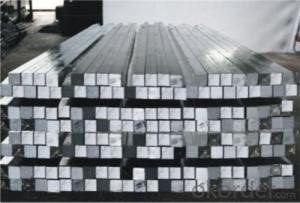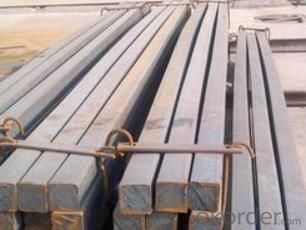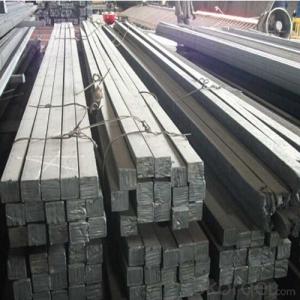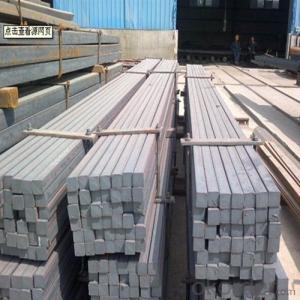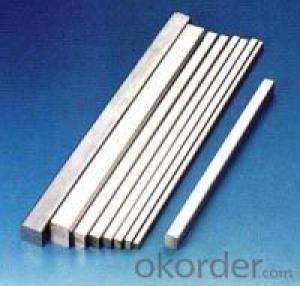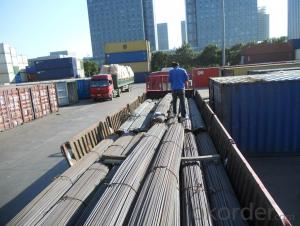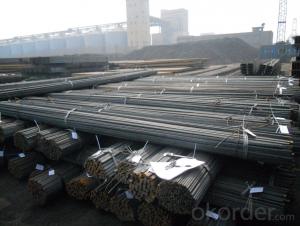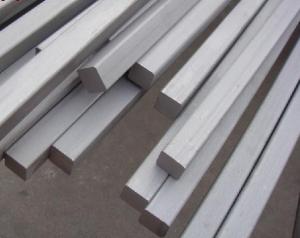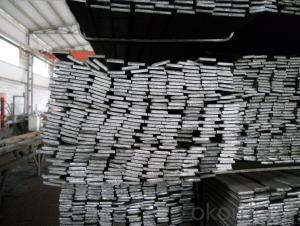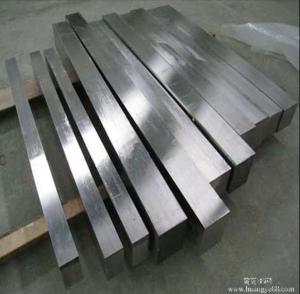Hot Rolled High Quality Square Carbon Steel Bar
- Loading Port:
- China Main Port
- Payment Terms:
- TT or LC
- Min Order Qty:
- -
- Supply Capability:
- -
OKorder Service Pledge
OKorder Financial Service
You Might Also Like
Product Description:
OKorder is offering Square Bar at great prices with worldwide shipping. Our supplier is a world-class manufacturer of steel, with our products utilized the world over. OKorder annually supplies products to European, North American and Asian markets. We provide quotations within 24 hours of receiving an inquiry and guarantee competitive prices.
Product Applications:
-The Square Steel is normally used as structure steel.
-Row material for other structure steel like steel angles, channels, I-beams, H-beams, etc…
Product Advantages:
OKorder's Square Bar are durable, strong, and resist corrosion.
Main Product Features:
· Premium quality
· Prompt delivery & seaworthy packing (30 days after receiving deposit)
· Corrosion resistance
· Can be recycled and reused
· Mill test certification
· Professional Service
· Competitive pricing
Product Specifications:
1. Grade: Q195, Q235, Q345
2. Diameter: 6mm-150mm
3. Length: 6m, 9m, 12m or as customer’s request
4. Tolerance: Within ±5% for weight; ±2mm for diameter
5. Note: The price can be better is the quantity is good
6. Chemical composition
Standard | Grade | Element (%) | ||||
C | Mn | S | P | Si | ||
GB | Q195 | 0.06~0.12 | 0.25~0.50 | ≤0.050 | ≤0.045 | ≤0.30 |
GB | Q235B | 0.12~0.20 | 0.30~0.70 | ≤0.045 | ≤0.045 | ≤0.30 |
-Mechanical Properties:
Mechanical Properties | Grade | Steel diameter(mm) | |||
≤16 | 16~40 | 40~60 | 60~100 | ||
Yield Point Δs/MPa | Q195 | ≥195 | ≥185 | - | - |
Q235 | 235 | 225 | 215 | 205 | |
Tensile Strength | Q195 | 315~390 | |||
Q235 | 375~500 | ||||
Elongation δ5% | Q195 | ≥33 | ≥32 | - | - |
Q235 | 26 | 25 | 24 | 23 | |
Packaging & Delivery of Square Steel Bar:
-Packing Detail:
1, The products can be packed in bundles by steel wires.
2, The weight of each bundle no exceed normally 3 tons.
-Marks: We make tag marks and color marks for each bundle. The tag marks with white background and red company log will be tied up to each bundle. The information is usually including basic information of company and products like product name, specification, etc...and other information required by customers. As for color marks, we will paint both ends of each bundles to make sure that it will be more convenient for customers to distinguish theme from other products.
-Delivery Detail: 30~45 working days after receive buyer’s T.T. or L/C.
FAQ:
Q1: Why buy Materials & Equipment from OKorder.com?
A1: All products offered byOKorder.com are carefully selected from China's most reliable manufacturing enterprises. Through its ISO certifications, OKorder.com adheres to the highest standards and a commitment to supply chain safety and customer satisfaction.
Q2: How do we guarantee the quality of our products?
A2: We have established an advanced quality management system which conducts strict quality tests at every step, from raw materials to the final product. At the same time, we provide extensive follow-up service assurances as required.
Q3: How soon can we receive the product after purchase?
A3: Within three days of placing an order, we will begin production. The specific shipping date is dependent upon international and government factors, but is typically 7 to 10 workdays.
Images:
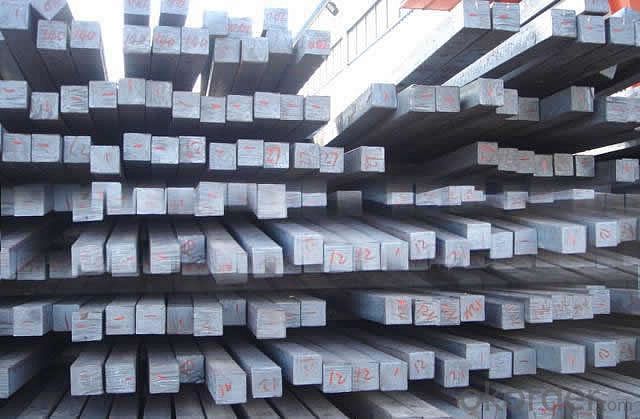
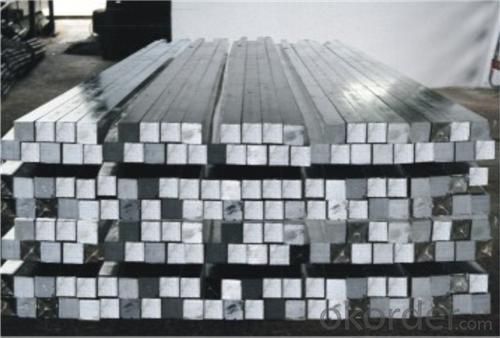
- Q: How do you use a steel square to lay out a trapezoid shape?
- In order to lay out a trapezoid shape using a steel square, a series of steps must be followed. Begin by determining the measurements of the trapezoid, which include the lengths of the parallel sides and the height of the shape. Proceed to mark the lengths of the parallel sides on the steel square. The steel square consists of two arms, namely the blade (the longer one) and the tongue (the shorter one). The blade is typically marked in inches, while the tongue is marked in fractions of an inch. Align the blade of the steel square with the longer parallel side of the trapezoid and mark the corresponding measurement on the tongue. Following that, rotate the steel square so that the tongue aligns with the shorter parallel side of the trapezoid. Mark the measurement on the blade that corresponds to the length of this side. After marking the lengths of the parallel sides, reposition the steel square to the base of the trapezoid. Align the tongue with the base and mark the measurement on the blade that corresponds to the height of the trapezoid. Once all the necessary measurements have been marked, connect the marked points to outline the trapezoid shape. To ensure straight lines, a straightedge or ruler may be used. It is important to double-check the measurements and make any necessary adjustments before cutting or constructing the trapezoid to ensure accuracy.
- Q: What are the common applications of a steel square in masonry work?
- A steel square, also known as a framing square or carpenter's square, is a versatile tool that is commonly used in masonry work. It can be used for various tasks, including measuring, marking, and cutting materials. One of the common applications of a steel square in masonry work is for laying out and checking right angles. Masons often use the square to ensure that corners are perfectly square, which is crucial for achieving proper alignment and stability in masonry structures. They can place the square against the corner of a wall or foundation to check if it forms a 90-degree angle. If it doesn't, adjustments can be made to ensure the accuracy of the construction. Another common use of a steel square in masonry work is for making precise measurements. The tool has markings along its blade and tongue, allowing masons to measure various dimensions accurately. They can use it to measure the length and width of bricks or blocks, ensuring that they are of the desired size and shape. In addition, a steel square can be used for marking lines on masonry materials. Masons often need to mark cut lines or reference lines on bricks, blocks, or other materials before cutting or installing them. The square's straight edge can be aligned with the desired line, and a pencil or scribe can be used to mark the material accurately. Furthermore, a steel square can also be utilized as a cutting guide. Masons sometimes need to make straight cuts on bricks or blocks to fit them into specific spaces. The square can be used as a guide for a masonry saw or chisel, ensuring that the cut is straight and precise. Overall, the common applications of a steel square in masonry work include checking right angles, making measurements, marking lines, and serving as a cutting guide. Its versatility and accuracy make it an essential tool for masons, enabling them to achieve precise and high-quality masonry construction.
- Q: Can a steel square be used for measuring angles in tile work?
- Yes, a steel square can be used for measuring angles in tile work. Steel squares, also known as framing squares or carpenter squares, are versatile tools commonly used in construction and woodworking. They have a 90-degree angle and a straight edge that can be used to measure and mark angles accurately. While a steel square may not provide precise measurements for more complex angles, it is suitable for measuring and marking 90-degree angles, which are commonly used in tile work. Additionally, steel squares are durable and easy to use, making them a practical choice for tile installation projects.
- Q: Can a steel square be used for checking the levelness of countertops?
- No, a steel square cannot be used for checking the levelness of countertops. A steel square is primarily used for measuring angles and ensuring the accuracy of right angles. To check the levelness of countertops, a level tool should be used. A level is a device with a bubble vial filled with liquid that allows you to determine if a surface is perfectly horizontal or vertical. This is important for countertops to ensure that they are level and provide a stable and even surface.
- Q: Can a steel square be used for checking the squareness of a drill press vise?
- It is possible to utilize a steel square for the purpose of examining the squareness of a drill press vise. A steel square, a tool featuring a right angle, is often employed in the evaluation of joint and surface squareness in both woodworking and metalworking. In order to assess the squareness of a drill press vise, one can position the steel square against the vise and observe whether the vise's edges align precisely with those of the square. If the vise is square, the edges will make complete contact with the square, thereby indicating its perpendicularity to the drill press table. Conversely, if the edges fail to align or if a visible gap exists between the vise and the square, it signifies that the vise is not square and may necessitate adjustment.
- Q: How do you use a steel square to find the length of a line?
- To determine the length of a line using a steel square, follow these steps: 1. Align one side of the steel square perfectly with one end of the line. 2. Securely hold the square in place while extending the other side along the line. 3. If the line exceeds the square's length, gradually move the square along the line while maintaining alignment, until you reach the end. 4. Once the square aligns with the line's end, measure the distance from the aligned side to the extended side's end. 5. This measurement will provide the line's length. It is crucial to acknowledge that using a steel square may not yield the same level of accuracy as a measuring tape or ruler, especially for longer distances. Steel squares are primarily intended for measuring right angles and ensuring squareness. Therefore, for precise measurements, it is advisable to utilize a more accurate measuring tool.
- Q: How do you use a steel square to determine the slope of a ramp?
- To use a steel square to determine the slope of a ramp, you will need to follow the following steps: 1. Place the steel square at the bottom of the ramp, ensuring that the long edge of the square is in contact with the surface of the ramp. 2. Hold the steel square in place and align the level vial, which is located on the square, so that it is parallel with the long edge of the square. 3. Slowly lift the other end of the steel square until the level vial indicates that it is perfectly level. 4. Once the steel square is level, measure the height of the lifted end of the square from the ground. This can be done by using a measuring tape or ruler. 5. Measure the horizontal distance from the bottom of the ramp to the lifted end of the square. Again, use a measuring tape or ruler for this step. 6. Now, to determine the slope of the ramp, divide the height measurement by the horizontal distance measurement. This will give you the slope ratio or gradient of the ramp. 7. If you prefer a percentage slope, multiply the slope ratio by 100. This will give you the percentage of the slope. For example, if the height measurement is 2 feet and the horizontal distance measurement is 10 feet, the slope ratio would be 2/10 or 0.2. To convert it to a percentage, multiply 0.2 by 100, resulting in a 20% slope. By following these steps, you can accurately determine the slope of a ramp using a steel square.
- Q: Can a steel square be used for checking the plumbness of a post hole?
- Yes, a steel square can be used for checking the plumbness of a post hole. A steel square is a versatile tool that is commonly used in woodworking and construction. It has a 90-degree angle that can be aligned with the sides of the post hole to check for plumbness. By placing the steel square against the sides of the hole, one can determine if the walls are straight and vertical. If the steel square does not align properly, adjustments can be made to ensure the post is set in a plumb position. However, it's important to note that while a steel square can be helpful for initial checking, a more accurate measurement can be obtained by using a plumb bob or a level to ensure the post is perfectly vertical.
- Q: What are the different ways to read measurements on a steel square when working with metal?
- When working with metal, there are several ways to read measurements on a steel square. The steel square, also known as a framing square or a carpenter's square, is a versatile tool that is commonly used in metalworking and woodworking projects. Here are some different ways to read measurements on a steel square: 1. Measuring length: To measure the length of a metal piece, place the steel square against one edge of the metal and align it with the other edge. Read the measurement where the opposite edge of the steel square intersects with the metal. This will give you an accurate length measurement. 2. Marking angles: The steel square is also useful for marking and measuring angles. One common method is to use the 90-degree angle of the square to mark a right angle on the metal. You can also use the square to measure and mark other angles by aligning one side of the square with the desired angle and marking the metal along the other side. 3. Checking for squareness: Another way to use a steel square is to check for squareness or perpendicularity. Place the square against a corner of the metal and observe if the opposite corner aligns perfectly with the edges of the square. If it does, then the metal is square. If not, adjustments can be made to ensure squareness. 4. Transferring measurements: The steel square can also be used to transfer measurements from one piece of metal to another. Simply place the square against the edge of the first piece, align it with the desired measurement, and mark the second piece along the edge of the square. This ensures accurate and consistent measurements. 5. Determining centerlines: The steel square can be used to find the centerline of a metal piece. Place the square against the edge of the metal, align it with the opposite edge, and mark the center point where the square intersects with the metal. This is especially useful for tasks like drilling or cutting holes in metal. Overall, reading measurements on a steel square involves aligning the square with the edges or angles of the metal and observing the points where they intersect. Whether you are measuring length, marking angles, checking for squareness, transferring measurements, or determining centerlines, the steel square is an essential tool in metalworking that provides accurate and reliable measurements.
- Q: Can a steel square be used for measuring heights or depths?
- No, a steel square is not typically used for measuring heights or depths. A steel square is a versatile tool used primarily in woodworking and carpentry for marking and measuring angles and as a guide for making straight cuts. It consists of a long arm and a shorter arm that meet at a 90-degree angle. While it can be used to measure distances and lay out lines, it is not designed to accurately measure heights or depths. For measuring heights or depths, specialized tools such as tape measures, rulers, or calipers are more suitable.
Send your message to us
Hot Rolled High Quality Square Carbon Steel Bar
- Loading Port:
- China Main Port
- Payment Terms:
- TT or LC
- Min Order Qty:
- -
- Supply Capability:
- -
OKorder Service Pledge
OKorder Financial Service
Similar products
Hot products
Hot Searches
Related keywords
